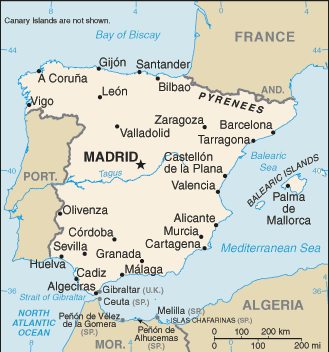Welcome to the Virtual Education Wiki ~ Open Education Wiki
Spain
by authorname authorsurname
Experts situated in Country
Country in a nutshell
Spain in a nutshell
Spain or the Kingdom of Spain, is a country located mostly in southwestern Europe on the Iberian Peninsula.
Spanish territory also includes the Balearic Islands in the Mediterranean, the Canary Islands in the Atlantic Ocean off the African coast, and two autonomous cities in North Africa, Ceuta and Melilla, that border Morocco. With an area of 504,030 km², Spain is the second largest country in Western Europe after France.
After serving as a granary of the Roman Empire, much of Spain was later conquered by a Muslim people, the Moors. Christian kingdoms gradually rolled back Muslim rule, completing this Reconquista in 1492. Spain became the leading world power, with a global empire on a scale and world distribution that had never been approached by its predecessors and a legacy today of over 400 million Spanish-speakers worldwide.
Napoleon's invasion of Spain in the early 19th century triggered independence movements that tore the empire apart and left the country politically unstable. In the 20th century it suffered a devastating civil war and came under the rule of a dictatorship, leading to years of stagnation. Democracy was restored in 1978 and the country has subsequently experienced a cultural renaissance and steady economic growth. Spain is now a constitutional monarchy organised as a parliamentary democracy and has been a member of the European Union since 1986, and NATO since 1982.
Bold textThe education system in Spain is organised into mainstream education and Enseñanzas de Régimen Especial (specialised education). Primary education (6 to 12) and compulsory secondary education (12 to 16) correspond to basic education, which consists of ten years of free and compulsory schooling for all pupils. Mainstream education comprises:
Pre-primary education (Educación Infantil): it is the first stage in the education system and it is non-compulsory. It is divided into two stages: the first one, up to the age of 3, and the second, from 3 to 6 years of age
Primary education (Educación Primaria): it is the first compulsory stage of the system. It covers six years of instruction, divided into three two-year cycles. It is normally completed between the ages of 6 and 12.
Secondary education In the Spanish education system, secondary education is comprised of compulsory secondary and post-compulsory secondary. The former - Educación Secundaria Obligatoria (ESO) it is divided into four courses and it is ordinarily completed from the ages of 12 to 16, it covers four school years and must be completed after finishing primary education. Successful students are awarded a Secondary Education Certificate, which is necessary for entering further optional education as is Bachillerato for their University or Formacion Professional (Vocational Studies).
Post-compulsory secondary education includes two options: the two-year Bachillerato (form 16 to 18), and intermediate vocational training ciclos formativos, the duration of which varies between one and a half or two years. Secondary education also includes artistic professional Music and Dance education, intermediate professional Sports and Plastic Arts and Design education, which belong to enseñanzas de régimen especial. This also covers language education. This provision, although not regarded as part of secondary education, belongs to Enseñanzas de Régimen Especial, which may be started at the age of 16 or 14 if the language to be studied is different from the one studied during ESO. Enseñanzas de Régimen Especial are non-compulsory and structured into different levels and degrees leading to different qualifications and certificates.
The vocational training is also a common possibility after ESO or after the Spanish Baccalaureate. There are two different types of programs: Middle Grade Training Cycles (Ciclos Formativos de Grado Medio), which have the ESO diploma as a requirement, and Superior-level Training Cycles (Ciclos Formativos de grado Superior), which have the Spanish Baccalaureate as the principal requirement. After completion of the Superior-level Training Cycle, students are entitled to direct entrance to several related University degrees (source wikipedia)
University education: Once students have finished their Bachillerato, they can take their University Entrance Exam (Pruebas de Acceso a la Universidad, popularly called Selectividad) which differs greatly from region to region. University in Spain is organised into three cycles, namely Bachelor, Masters and Doctorate, with variable duration and a minimum required number of ECTS credits.
